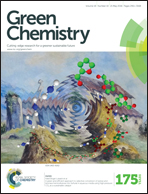Itaconic acid – a versatile building block for renewable polyesters with enhanced functionality
Abstract
The increased implementation of renewable resources in the chemical industry is mainly driven by environmental reasons. However, as a rather underestimated side-effect of this development, new chemical building blocks have become available, which are not economically accessible from petrochemical sources. In this respect, itaconic acid has gained considerable attention, as it is biotechnologically produced from carbohydrates on an industrial scale. Its trifunctional structure allows for the synthesis of new polymers, like polyitaconates or related co-polymers which have been extensively studied in the past. Polyesters derived from this unsaturated dicarboxylic acid on the other hand have only recently started to gain interest, despite myriad potential applications, such as UV-curing resins for coatings, inks or adhesives or thermally curing compositions to name but a few. This work aims to review the most relevant work in the field of polyesters derived from itaconic acid and to show the unique properties of these materials and identify the potential for further research in this area.


 Please wait while we load your content...
Please wait while we load your content...